ALICE IN WONDERLAND - AND THE SHROUD OF TURIN?
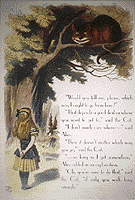 |
Let us sort out together what has gone wrong. Fortunately, almost all of the ideas conceived in Wonderland involve the expertise of the fine arts to unravel, and rebut.
STEPPING OUTSIDE OF ONE'S EXPERTISE
Perhaps the most repeated trip into Wonderland is when experts, great in their own right, step out of their own field of expertise and get involved with someone else's profession. The result can be dangerous.
FAINT IMAGE
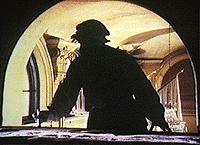 |
This is how an artist never paints (RIGHT). You can do an inscription or an abstract Textile design like this, but never a painting. The practice of the monumental arts is known to be the hardest profession on earth. I should know.
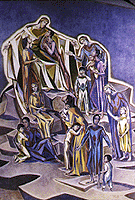 |
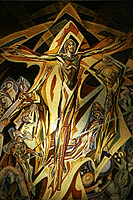 |
(LEFT) This is my last, completed mural, just dedicated by Cardinal Mahony three weeks ago. It is at St. Anne's home in Los Angeles.
An eleven hundred square foot mural at Holy Cross Mausoleum (RIGHT)
A 480 square foot painting in the Vatican's Pontifical Biblical Institute in Rome, which I painted when I was 14 years old and which I visited this May. (BELOW)
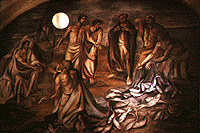 |
A 2,000 square foot mural at the Guardian Angel Cathedral in Las Vegas. (BELOW)
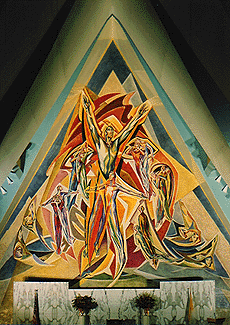 |
Note, that I had to paint it from a scaffold.The figures are much too large to see them from close. This is true of any painting with figures life-size or larger. The Shroud has two life-size figures on it.
The artist has to climb down to ground level every 20 minutes, look at the work from a great distance and make a mental and intellectual decision how to paint the mural. This is true each and every time one paints a monumental painting. I had to climb the scaffold of my very latest mural under work now in Palos Verdes, CA. to which I will return from here.
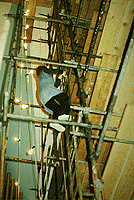 |
From the scaffold all I see is barely distinguishable spots. From a distance, however, the image of the Eucharist Christ, the Angel crying out the glory of the eucharist, the Angel inviting and a symbolic figure - the hand holding grapes gather themselves into a definitive image, exactly as the Shroud does. The Shroud is not a painting, not because it becomes a well defined image only from a distance, and the artist would have needed a 15 feet long brush to paint it. He just needed his specific art training exactly for the purpose to paint from a long distance. The task to prove whether the Shroud is or is not a painting belongs to the expertise of the practiced monumental arts. Crossing the borders of expertise is very dangerous, as we have seen through the example presented.
CROSSING THE BORDERS OF A CULTURAL MILIEU AND ITS EVENT HORIZON.
When Shroud research finds itself in Wonderland, not only the borders of professional expertise were crossed, but the borders of a specific cultural milieu and its forbidding event horizon. Every historical epoch creates a magic ring, an intense milieu, with an event horizon that cannot be crossed.
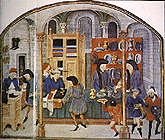 |
Within this milieu there is harmony, equilibrium. Everything from its politics, economic system, beliefs, aspirations, art and style, clothing, manners and the last button on their coat fits into this enduring magic, almost like a spell, which creates a milieu, an era.
You cannot implant 20th century ideas and mentality into the milieu of another age, exclaiming that they had all the materials around them and could have developed the technology to achieve photography, a knowledge of chemistry and scientific logic. Could all these things be developed at the same time and co-exist?
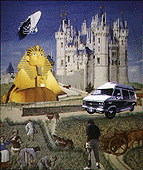 |
Why did the medieval monks have to write their codexe's painstakingly with brush? All the forces of nature existed around them as today and all the materials were laying right there to make the computer. Why didn't they?
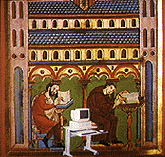 |
Why do we have to build space shuttles and space vehicles? Why not fly in space like this, as probably at the end of the 21st century people will. They will wonder what was wrong with us not to do it when everything was at our fingertips for this technology? Could a genius among us have come up with this secretly, tried it just once and left no notes about it?
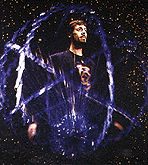 |
IS THE SHROUD A PRIMITIVE PHOTOGRAPH MADE BY LEONARDO DA VINCI?
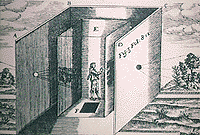 |
Very recently, a program appeared on television suggesting that the Turin Shroud was made by Leonardo da Vinci, who just to produce the Shroud, (LEFT) invented a primitive form of photography in the 15th century, three and a half centuries before the French made the first photograph in a camera in 1826. Let us see if he could have done that. For starters, the first recorded exhibition of the Shroud in Lirey France was in 1356. Leonardo da Vinci was born in 1452, a hundred years after the exhibition.
Secondly, one has to know a great deal more about the life, work and success of Leonardo. He designed an earth digging machine. It would have taken 2,000 men two and a half years to excavate as much as what 200 men could have done in six months.
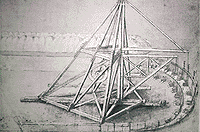 |
He designed one canon and weapon after the other, with principles which mankind reinvented centuries later.
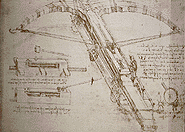 |
But they were all too big, required too many people to operate them, and they were made from primitive materials, mostly wood. None of them went into production.
He invented the bicycle, but made from wood. It did not
work.
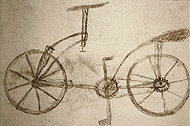 |
He designed a flying machine resembling bat's wings. Not
knowing the laws of aerodynamics, the flying machine did not
work either.
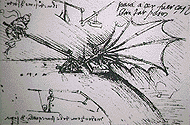 |
He made the model of a colossal equestrian Statue of
Francesco Sforza, Duke of Milan. He designed a method for the
casting of the statue in bronze in a single piece. It was an
ingenious plan, but one which did not work.
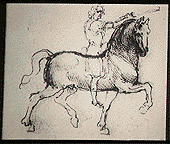 |
His greatest masterpiece, the Last Supper, started to
disintegrate within his own lifetime due to technical errors.
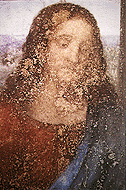 |
Besides, he who wrote down in reverse every penny he spent, everything he ever invented, never wrote one word about the Turin Shroud. One of the greatest geniuses of all times, Leonardo da Vinci, also was one of the most unsuccessful people of history. Leonardo creating the Shroud of Turin, which defies time with its uncanny permanence? I do not think so.
VISUAL AIDS FOR THE ARTIST - SCIENTIFIC INSTRUMENTS?
Today, there is a great interest in Wonderland in the Camera Obscura. The original function of it is greatly misunderstood. It was not developed as a scientific instrument, even less as an archaic photo camera. It was an aid for the artist and that is all it was. It is not the only aid. There are many aids used by artists, different ones at different times.
Let us see some of them. Most of them are to aid in the
representation of buildings, and open space in perspective. It
is for that purpose that also camera obscura was used.
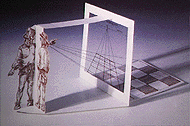 |
First mentioned by Pliny, it is obvious that the Greco-Roman
muralist used it, Creating in closed rooms the illusion of open
space. The Roman artists noticed that lines run toward a
vanishing point. They did not speculate that light propagates
itself in straight lines.
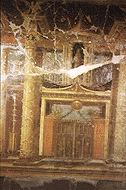 |
The properties of light and optics started to be studied
by artists only from the renaissance on.
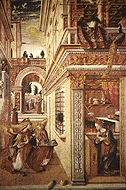 |
It is entirely obvious that the medieval artist neither used
a camera obscura, nor even knew about it or about the scientific
properties of light.
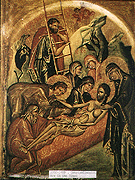 |
(46) It was after the classical Greco-Roman writers were
translated and the passages in Pliny were found, also with the
excavations of Roman murals, that artists re-invented the camera
obscura for their own purposes, long after the Turin Shroud
already was exhibited.
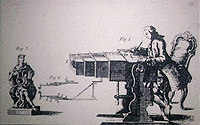 |
Other aids for the artist were used to study foreshortening
on figures. Thank God that Wonderland did not discover those yet.
These instruments would not have been needed at all, if anyone
among artists would have invented photography.
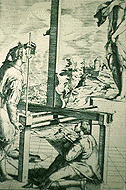 |
The artist's interest in optics, so independent from the
camera obscura can be seen even later. Here OP Art:
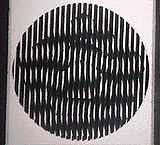 |
Kinetic Illusion:
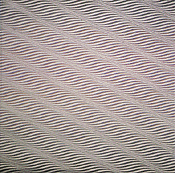 |
And examples of continuous movements in space.
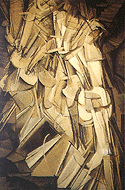 |
SOUTH AFRICA: THE CAMERA OBSCURA, OPTICAL QUALITY CRYSTAL, UV RADIATION, SILVER NITRATE...AND URINE? LET US NOT FORGET THE CORPSE.
Let us not forget the Monks in Wonderland using a computer in the 12th century, either.
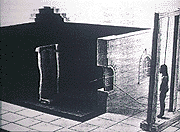 |
Again, we hear the magic words; I quote "using materials that were available in the 13th century." Never mind that an analytical and scientific thinking was not developed yet in the 13th century capable of bringing together the following process: a camera obscura not in use in the 13th century, the classics not yet translated, chemistry not yet invented, yet knowing the exact chemical properties of silver nitrate, knowing its light sensitive properties, without any knowledge of optics or the properties of light employing a bi-convex, finely ground quartz lens, knowing the properties of UV radiation before electromagnetism was known at all, knowing how to stabilize the image by ammonia or knowing the chemical properties of urine. Knowing that some day, from the negative through photography a positive image will be achieved. But how come, that not knowing the most evident fact, that corpses do not maintain rigor mortis or that they cannot hang for 14 days in the sun, or else you would not care to see what the camera obscura would bring in onto your canvas.
I think in this experiment the Cheshire Cat truly was at
work.
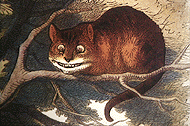 |
SCIENTIFIC DATA
The fact is, the South African study makes some other gross mistakes. The earliest lenses bi-convex in shape, where made for eyeglasses in the 14th century only. The theory of image formation by lenses was first studied by Sir Isaac Newton and Renee Descartes in the second half of the 17th century and particularly by Carl Friedrich Gauss in the 19th Century, who first introduced the idea of focal length. Giovanni Battista della Porta introduced in the 16th century the process of lens grinding and polishing which would have been absolutely necessary for the 13th century solarograph. Also in the 16th century, Daniel Barbaro of Venice mounted a convex eyeglass lens in the pinhole of a camera obscura for the first time in history to achieve a focused image on the opposite wall by bending the rays of light. The South African researcher also places the making of the Shroud-like camera obscura negative into Venice, but with a little three hundred years difference in the wrong time direction, way before the method was historically achieved.
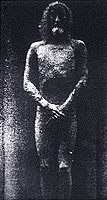 |
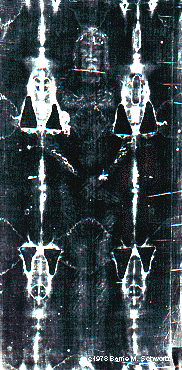
|
What is even more remarkable is the mistake on this positive photograph (left), supposedly the result of the camera obscura experiment from South Africa. The corpse or body cast was supposed to hang fourteen, fifteen days out in the all day sun. As the sun moveS across the sky from morning till evening every day, it should evenly light the corpse without any effect of a light focus (direction of light). This photo shows a very easily visible, strong, directional light focus coming from the upper left side. The photo clearly is not the result of the process described.
The Turin Shroud (right), shows absolutely no light focus (direction of light).
THE CARBON DUST TRANSFER TECHNIQUE.
This suggestion is as follows: First an initial drawing in negative has to be made on paper, using various powdered pigments, such as charcoal or oxides, using also some binders. According to the research, it is just the same what kind of binders to use, never mind how different the results are with every binder known to the professional arts. The image then is transferred to the cloth with a wooden burnishing instrument and finally set with heat.
"It was so simple" - said one of the two researchers. "I
went home and with a few things lying about the house, I duplicated
the process" - The Shroud-like image that is. What one finds in an
American 20th century home... would anyone be able to find in this medieval home?
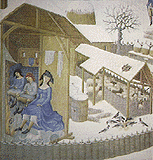 |
Again, we see the ever returning mistake of crossing the forbidding event horizon of the milieu of a bygone historical era, placing our own ideas and modern circumstances into it.
Let's illuminate this further with an example. The red paint
cinnabar, the natural forerunner of the later, alchemically
produced vermilion, was already known in Assyrian and Greek
times. Cinnabar also remained in use in the Middle Ages.
Theophrastus's "History of Stones", written in the 4th Century
B.C. and incorporated into Pliny, describes that the ore of
cinnabar was obtained from inaccessible cliffs of Spanish
mountains by shooting arrows to dislodge it. Medieval recipes
add to this only one thing. The painter had to hire a top archer
and had to be ready to be attacked by thieves on the way back.
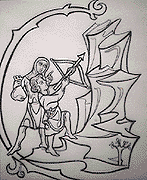 |
The oxides are not much more promising in the Middle
Ages. These are native clay colored by small amounts of iron and
manganese. The best varieties are found in small deposits or
pockets. Finding cinnabar, oxides or any other dry pigments in
a household in the Middle Ages? I don't think so.
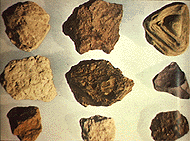 |
We also find again in this theory the crossing the borders of one's own expertise and entering into someone else's professional territory without proper knowledge.
The focal point of any Shroud research has to be the
realization, that the positive image of the Turin Shroud is an
entirely personal, and lifelike portrait of a real man, not a
composite, nor abstract or symbolic "image". The success of the
described method incorporated in the Carbon Dust Transfer
technique wholly depends on an initial drawing created by the
use of carbon dust or iron oxide.
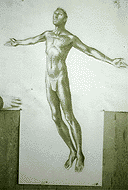 |
I have learned how to draw the human figure to the extent that I
won the international Grand Award for figurative draftsmanship
which supposedly makes me one of the world's best figurative
draftsman. Yet, I could not have drawn the Turin Shroud in this
late 20th century.
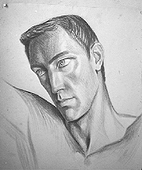 |
DRAFTSMANSHIP
The initial drawing for the Dust Transfer Image, in order to have the qualities of the Shroud, would have had to introduce a degree of draftsmanship we cannot produce even today.
In the Middle Ages that kind of draftsmanship was non-
existent.
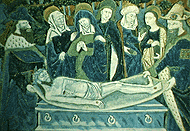 |
The initial drawing would have had to include an anatomical
and medical knowledge, which was only barely touched upon
even in the High Renaissance.
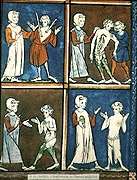 |
And a knowledge of Roman crucifixion methods in the first
century Judea we only learnt about in the late 20th century from
recent excavations.
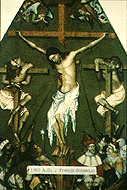 |
The first ever portrait painting after the fall of the Roman
Empire was that of Enrico Scrovegni in Padua at the Arena
Chapel in 1304. Even though it was done by the great Giotto, it
is at astronomical distance in quality from the Shroud.
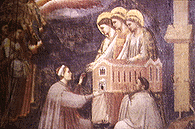 |
The development of portrait painting in its own right had
to wait till the coming of the renaissance masters a century and
a half after the Lirey exhibition of the Shroud.
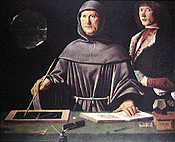 |
But a true realism in portrait painting was achieved only
by the painters of the French Academy from the last half of the 17th
to the end of the 19th century. It is at the same time that pastel
painting also was developed.
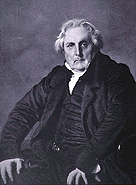 |
The art of pastel painting dates back only 200 years. The
carbon dust transfer theory makes mistakes in the techniques of
art and art history as well. The prehistoric paintings of
Lascaux, France, 20,000 B.C., Altamira, Spain, about 25,000 B.C.,
Font-de-Guame, France, also about 20,000 B.C., and others were
by no means pastel paintings. They also were not negative images.
The outlines of animals were first drawn by the use of a burnt stick
from the fire, the forerunner of today's charcoal stick. Then, the
forms were filled out with natural earth colors and chalk, mixed with
animal blood and animal fat. If some of these murals look like dusty
pastels, let us not forget the more than 20,000 years which have
passed. The binders mostly have disintegrated since. These
paintings survived only because they were painted deep inside
the caves, indeed not for public viewing as an exhibition, but
for magical ceremonies.
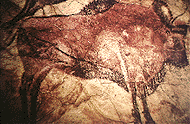 |
Between their time 20,000 years ago and just 200 years ago
our time, absolutely nothing happens on the field of pastel
painting, which the technique described by the Carbon Dust
Transfer Method, would have to be classified to be as for art
technology. It was only 200 years ago that the great pastel
portraits were started. Although most nonprofessionals would
think that pastels do not need a fluid vehicle or medium, this
is only partially true. The particles are not cohesive enough to
show minimal adhesion. They simply dust offand crumble. They
need a weak solution of a binder. In the past this was gum
tragacanth and water. When the image was completed, to
prevent the particles from falling off, a pastel fixative also
is applied to the surface. Even with these precautions, if pastels
are hand l smudging and even total destruction is self-evident.
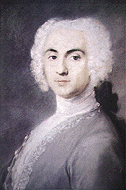 |
It is entirely unimaginable that a 14' cloth with pastel-like
substance on it, would not dust off, smudge or that it could be
evenly set by steam. We should not confuse loose dry pigments
with anilyn textile paints, which would cooperate with steam.
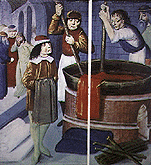 |
At any rate, the Middle Ages did not have fine ground
pigments we have today, only handground pigments.
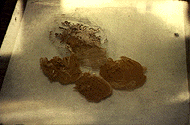 |
The handground, coarse dry pigments of the Middle Ages would not lend themselves to achieve an image with the superb qualities of the Shroud Image, especially when transferred to a coarse, unprepared linen with a herringbone weave, such as the Shroud. The image would greatly deteriorate and distort with the fine details absolutely lost. Besides, the Shroud image does not have the visual qualities of a secondary, depression image, but resembles more a direct projection of a real man.
ANCIENT TEXTBOOKS: CENNINO CENNINI DA COLLE VALDELSA, 1437 - THEOPHILUS PRESBYTER, 12TH CENTURY
The Authors of the Carbon Dust Transfer Technique refer to Cennini's book, "Trattato Della Pittura" and Theophilus Presbyter's book "The Various Arts". The reference is made to these books in an obscure manner for evidence for the existence of the Carbon Dust Transfer technique in the Middle Ages. Neither of the ancient authors reveal any technique similar to that which was described.
A warning! The translations of the book of Theophilus
Presbyter and Cennino Cennini had to be adopted to the modern
understanding of the technology of art materials and practices.
Some of the ancient expressions are still under discussion and
newer editions are undergoing multiple corrections. It is not
that easy to know in most cases the true meaning of the words and
which modern materials they correspond to, if any. These books
are only for the understanding of professional artists and restorers
of museum quality and not for lay people. Grave misunderstandings
are bound to happen when non-professionals try to interpret and
adopt materials and techniques based on these ancient formulas.
Finely ground pigments, drawing techniques of photographic accuracy,
pastel portraits and the very thought of a negative image on a burial
Shroud, do not fit the milieu of the Middle Ages.
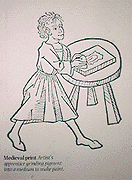 |
This is when the Phoenician barge arrives into New York
harbor and the Cheshire Cat gives all the answers when the
borders of professional expertise are crossed.
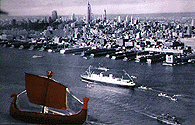 |
CHRIST DID NOT DIE ON THE CROSS?
Beautiful! I just don't understand what is the Turin Shroud doing among us then. What is its purpose? I just want to discuss the image making, direct contact mechanism suggested by the two researchers, who originated this theory. This, as a matter of fact, involves art anatomy more than any other discipline. Unfortunately there is time only for a few statements, making a lengthy study very short.
Professional art anatomy sees absolutely no distortions on the image of the Man of the Shroud, front or back.
NO ROOM FOR PERSONAL OPINION
In art anatomy there is no room for personal opinion. It is based on strict rules of proportion, structure and rules of foreshortening. Every highly trained figurative artist would read these rules exactly the same way.
The Man of the Shroud is leaning forward, his head is at
a gentle angle, his knees are pulled up.
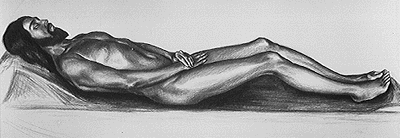 |
After I completed these studies I came across the work of my late colleague, Professor Lorenzo Ferri, who's conclusions were identical to mine.
Therefore one cannot determine the length of this body by
placing a measuring tape on the top of the hair and reading the
inches at the supposed toe.
 |
One would have to measure it like this, in our case relying
on empirical methods through art anatomy. This man, judging
also by the all important body type and its typical anatomy, cannot
be less than 5'11 1/2" and no more than 6'2".
 |
The head is not small, as some claim, one just does not
see the sides of the cheeks. But the eyes and nose
measurements, also when measuring from forehead to chin, the
head is absolutely correctly proportioned compared to the body
type. The arms are parallel with the Shroud, therefore we see them in
full length. The chest and the upper and lower legs stand at an
angle to the surface of the Shroud, therefore, inchwise we do
not see them in full length. But as an image involved with the laws
of optical foreshortening, again the body on the Shroud is perfectly
proportioned.
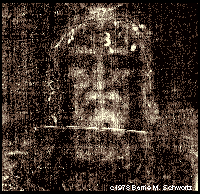 |
An undeniable and totally unexplainable fact however
remains. The body may have been originally wrapped like this in
the Shroud.
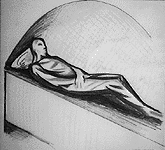 |
But at the moment when the image was projected on the
Shroud, so to speak, the top half and bottom half of the Shroud,
both, have been absolutely straight, more straight than any cloth
under normal circumstances could be. The undistorted anatomy
of the body proves that. It is further proved by the fact, that
there is no image of the two sides of the Man on the cloth. Whatever
system designed the image on the cloth, simply had no surface
to design the sides upon.
 |
Under these circumstances and because of the leaning
body and pulled up legs, the Shroud touched the body only at a
few places. A direct contact image created by any method, aloes
and sweaty chemicals or fungi, has to be absolutely excluded.
The dorsal image especially proves that. There is a distance of
81/2 to 9 1/2" between the straight cloth and the back of the knee.
 |
Has the cloth really been straight? Illustrated and
simplified on this diagram, the distance marked AB is the real
length of the thigh. If the Shroud at the moment of image
formation would have been wrapped around the body in full
contact, the full length of AB, the full length of the thigh would
be seen on it. As it is we see AC, the projected and foreshortened
length of the thigh on the Shroud. This proves the Shroud was
straight at the time of image formation, and the dorsal image
should be shorter than the frontal, - which it indeed is.
 |
Editor's Note: At this point in her presentation, Isabel included a recap of her article, "Is The Shroud of Turin A Painting?" For the sake of brevity, I have edited this from the presentation. You can find the article in it's entirety on the"Scientific Papers & Articles" page of this website.
A ROAD TO FOLLOW?
As Shroud research has reached all the disturbing stages I have discussed here today, which way ought we to go from here?
"I don't much care where" - Said Alice in Wonderland, "so long as I get somewhere". "Then it does not matter which way you go", answered the Cheshire Cat. Maybe there is an answer better than this.
In 1896 in Paris, France, exactly a hundred years ago, the
ghostly image of a key was captured on a photoplate in the
drawer of a scientist; the plate was accidentally hidden under
a stone. He explained the strange phenomenon by believing that
sunlight was captured within the stone which slowly ejected itself
and caused the ghostly image of the key on the photographic
plate. The explanation falls back on traditional beliefs of the
physics of the times, but somehow did not entirely explain every
facet of the phenomenon and could not be repeated with other
stones. There was only one ghostly image of a key. Marie and
Pierre Curie did not succumb to the traditional explanation. Due
to their more original thinking a new quality of nature was found,
radioactivity. A new chapter in physics and theoretical chemistry
was opened, a star was found within matter.
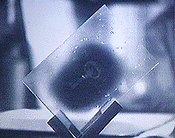 |
We too have a ghostly image on a piece of matter hidden first in a tomb and then in a silver chest. We too try to explain it through what physics and chemistry knows today: X-ray, Ultra-violet radiation, particle radiation, visible light or a chemical reaction. However, none of them explains entirely the ghostly image, just as the key was not explained by sunlight trapped in the stone. It was not explained before radioactivity was finally understood. This is the time when we have to think big and if we can, think even bigger. Marie and Pierre Curie had to find a star within a stone, we have to find the universe within a piece of cloth.
The true universe, is even more extraordinary than we thought.
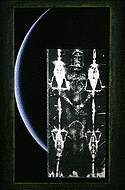 |
For the first time in history a window opens upon the inaccessible future. An all important question arises here, which better not be answered by the Cheshire Cat, but by the best of us.
Through the Turin Shroud...
The extraordinary blueprint...
The only window on the future in the cosmos, on the cosmos.